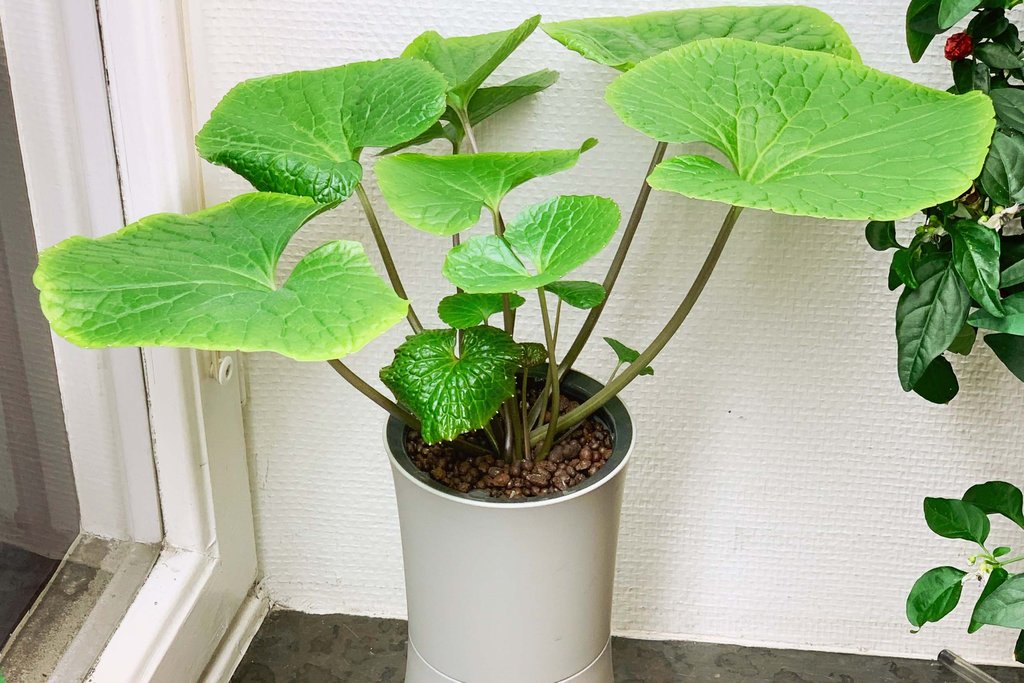Follow up - The Wasabi experiment

Last year in September we planted a wasabi in a Botanium as an experiment. Someone asked us if it’s actually possible to grow wasabi in Botanium, and since we are slightly obsessed with growing plants hydroponically, we had to find out. A few days ago it was finally time for us to harvest it since it already had out grow the Botanium.
Growing wasabi is truly a hobby for the patient. When growing commercially, it takes 2-3 years before the stem is 4 centimeters thick and is ready for harvest. Our hopes were that growing the Wasabi plant hydroponically in Botanium would speed up the process. So what's the result of growing a Wasabi in a Botanium for almost 9 months then? We're about to find out...

Our wasabi after a few weeks of growth
In Japan, the plant grows naturally along stream beds in mountain valleys, which is why it should thrive in a hydroponic system like Botanium where it gets constant access to water and air. It's very sensitive to direct sunlight, so it's crucial to keep it on a shaded but bright spot.
Harvesting the Wasabi from a Botanium was slightly more tricky than we first thought. The growing container was a bit too small for the roots to really grow in it and the roots were very tangled in. The plant however really thrived in a Botanium and grow big and beautiful.
How the roots looked like when pulling it out from the growing container
Even though you can eat all parts of the plant, wasabi usually refers the underground stem which the roots extend from - the so called rhizome. Once the plant has grown big, this underground part is harvested. It has a short shelf life and Is only grated right before it’s about to be eaten, since it quickly reacts with air and deteriorates.
For grating the wasabi we used a Japanese grater called oroshigane which makes the grated material stays on top. This type of grater is designed for grating wasabi or ginger, but it works just fine for any vegetable with a similar texture, like garlic or horseradish.

So what's the result of the experiment with the Wasabi plant? Growing it hydroponically really speeds up the process, even though Botanium as a growing container was a bit too small for the roots to grow big. However the plant itself has been a delight for the eye to look at with its beautiful green leafs. We're curious about what happens if we let it grow in coco coir next time instead of LECA as we used this time. To be continued...






Now you’ve perked my interest! I’m a horticulturist with decades of experience, and my question now is if it can grow in this medium, why not aeroponics. Have found starts for cheap, so I think I’ll give her a rum and see what happens. Would be great if you posted some values for ph, nutrients, but I imagine if I do some research into it’s traditional environment, that’ll give me a good place to start.
How long and wide was the Wasabi root after growing it in a Botanium for almost 9 months? What size of root did you start with?
Hello, :) May we please ask what is “coco coir” and what is “LECA” mentioned in the last paragraph of your article on “FOLLOW UP – THE WASABI EXPERIMENT”? Kind regards, Jen
This kind of plant are very easily to grow just like grass, but it takes more than a year to be matured.
Some one just want to exaggerate how difficult to cultivate so they can sell their product.
Just get a rhizome, chop into small pieces and let them dry overnight in the garage then poke them in the soil. Water once a week and enjoy.
Do you use leca clay balls as the growing medium? Do you need to ph the water? Can I place it by the window and use natural light instead of a grow light/florescent light? Thanks.
Leave a comment